Sweet Soy Sauce Substitute (Kecap Manis)
Kecap manis is a sweet aromatic soy sauce from Indonesia. Make your own homemade sweet soy sauce following the recipe, or try a sweet soy sauce substitute from the best sweet soy sauce alternatives list.
I adore shop-bought sweet soy sauce (Indonesian kecap manis), but it can be tricky to track down in a grocery store. Luckily this sweet soy sauce substitute recipe is quick and easy to make.
And if you don’t have ten minutes to cook the thick and syrupy soy sauce, I also provide a list of the best instant substitutes for sweet soy sauce.
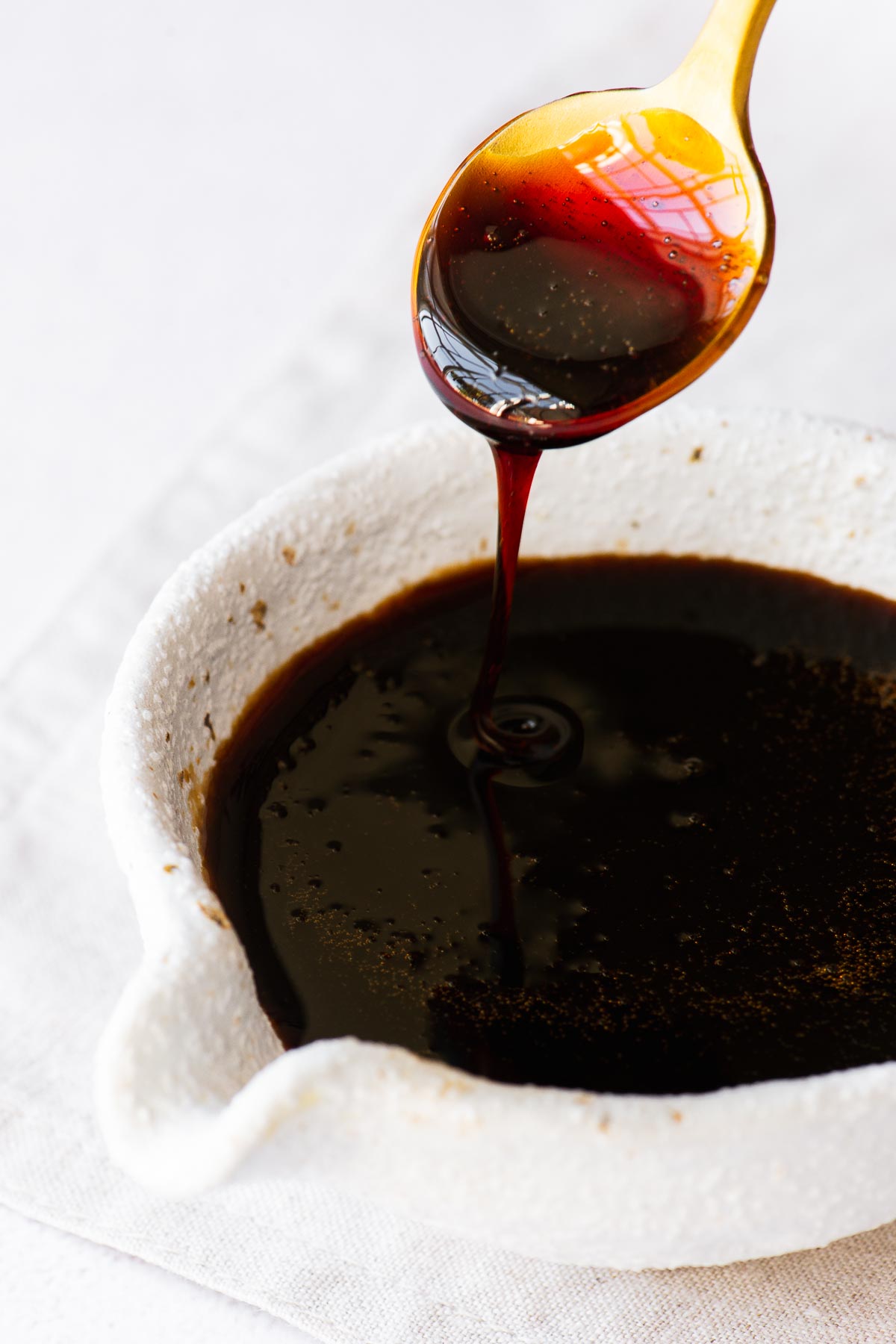
What is kecap manis?
Kecap manis (or ketjap manis) is a sweet aromatic soy sauce from Indonesia. The colour is darker than regular soy sauce (kecap asin) with a thicker consistency.
The sweet taste is thanks to a large amount of palm sugar, jaggery or molasses. Kecap manis may also contain spices such as cinnamon, star anise, black peppercorns, coriander and clove. I add a single star-shaped pod of star anise to my homemade sweet soy sauce.
Sweet soy sauce is an essential part of Indonesian cuisine. It adds the umami flavour to many popular Indonesian dishes like nasi goreng (Indonesian fried rice) and mie goreng (Indonesian fried noodles).
Kecap manis is also the base for Indonesian marinades, dipping sauces and salad dressings.
The best sweet soy sauce substitute
It is quick and easy to make sweet soy sauce at home – the perfect substitute for shop-bought kecap manis. Simply boil soy sauce and a sweetener until thick and syrupy.
If you don’t have time to boil and cool homemade sweet soy sauce, scroll down for the best sweet soy sauce substitutes.
Homemade sweet soy sauce ingredients
- Soy sauce: Most soy sauce, except dark soy sauce, will work with this recipe.
- Light soy sauce works best for kecap manis. It is the least salty with the lightest soy taste.
- All-purpose soy sauce, like Kikkoman soy sauce, also works well. This is what I tend to have at home.
- Avoid dark soy sauce since it already has a very intense sweet flavour. The label will explicitly say “dark soy sauce”.
- Palm sugar: Palm sugar or jaggery is the traditional Indonesian soy sauce sweetener. It has a deep caramel flavour. If you buy your palm sugar in brick form, you will need to grate it first. You can also use coconut sugar or brown sugar. Though brown sugar lacks the smoky undertone, it will still result in a soya sauce with a sweeter taste.
- Spices: I like to add a single star-shaped pod of star anise. It adds spice and depth to the sauce without overpowering the sweet, salty soy taste. You can also add a small piece of cinnamon.
Nagi from RecipeTin Eats has a great post on the main types of soy sauce if you are interested in learning more.
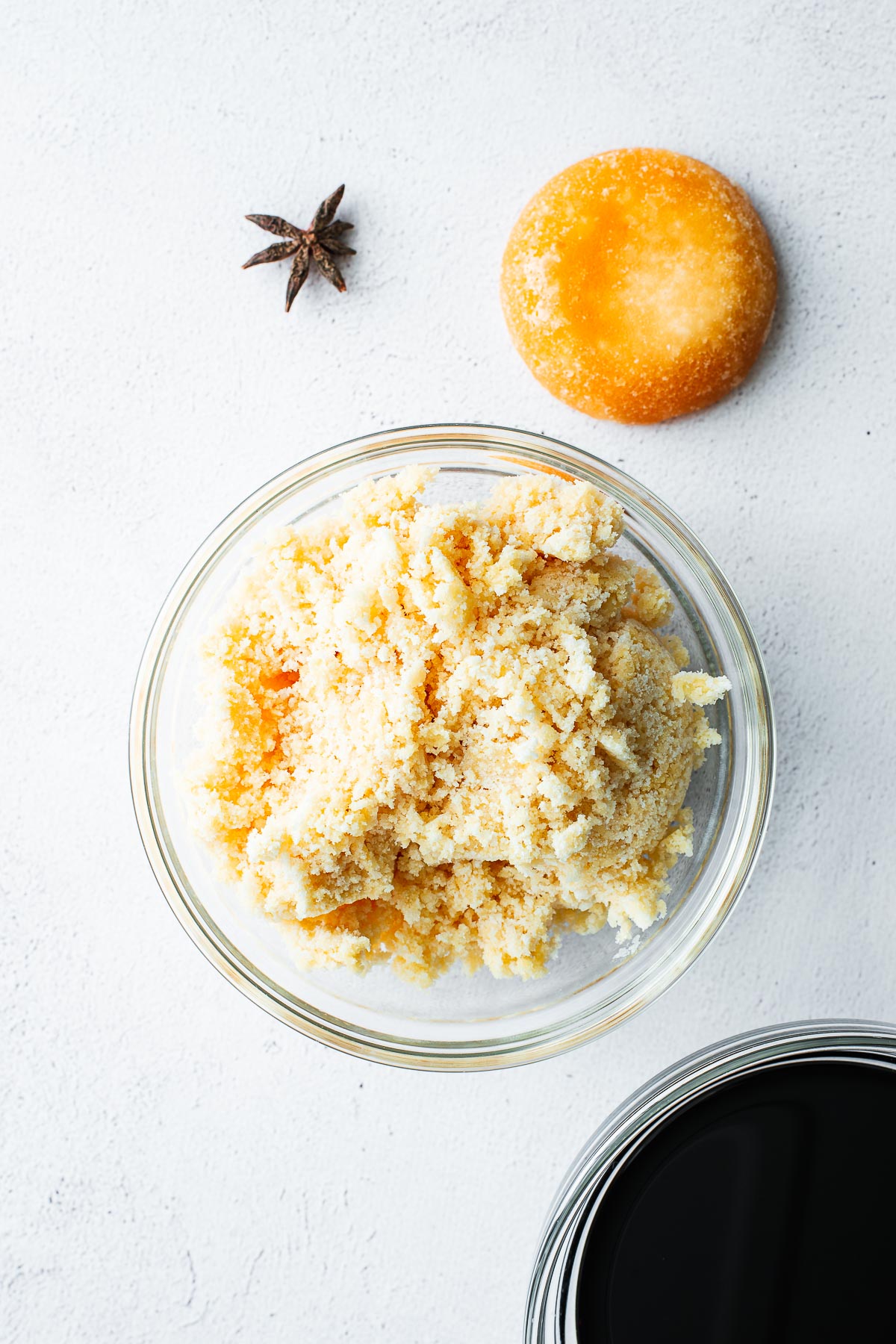
How to make sweet soy sauce
The best substitute for shop-bought sweet soy sauce is this homemade version. There is a concise recipe card at the end of this post.
To make kecap manis, add your choice of soy sauce (light, all-purpose or tamari) to a small saucepan. Stir in your grated palm sugar, coconut sugar or brown sugar. And add a single star-shaped pod of star anise.
The star anise is optional. But I love the addition. It adds a depth of flavour similar to the caramel, almost smoky, Indonesian kecap manis.
Bring the sauce to a boil over medium-high heat, then turn down the heat to simmer for five to ten minutes, stirring often.
Keep an eye on the sauce as it boils. If it is boiling violently, remove it from the heat for a moment and keep stirring. Once it calms down, place it back on the heat.
The sweet soy sauce will thicken as it simmers. Keep cooking until it has the consistency of maple syrup, ten minutes at most. It will continue to thicken as it cools down.
Set it aside to cool down completely. Use it straight away, or store it in an airtight container in the fridge. It should last well over a month.
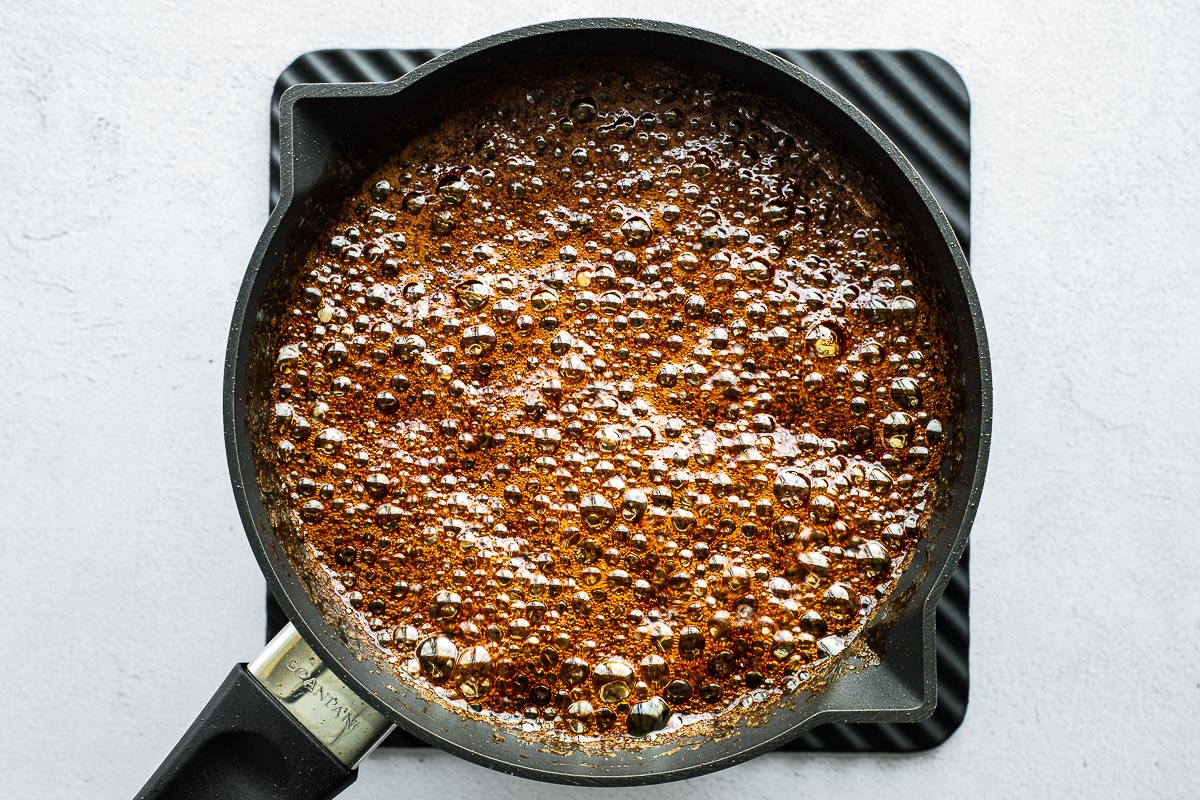
11 Substitutes for sweet soy sauce (kecap manis)
Sweet soy sauce is salty with a caramel sweetness and a thick, syrupy consistency. So, to find a sweet soy sauce substitute at home, you need to recreate this sweet and salty umami flavour.
Use these sweet soy sauce alternatives as a 1:1 substitute for shop-bought sweet soy sauce.
1. Homemade kecap manis (the best sweet soy sauce substitute)
The best substitute for kecap manis is homemade sweet soy sauce. Briefly boil light or regular soy sauce and sugar (preferably palm or coconut sugar, but brown sugar also works) until thick and syrupy.
See the sweet soy sauce recipe for instructions.
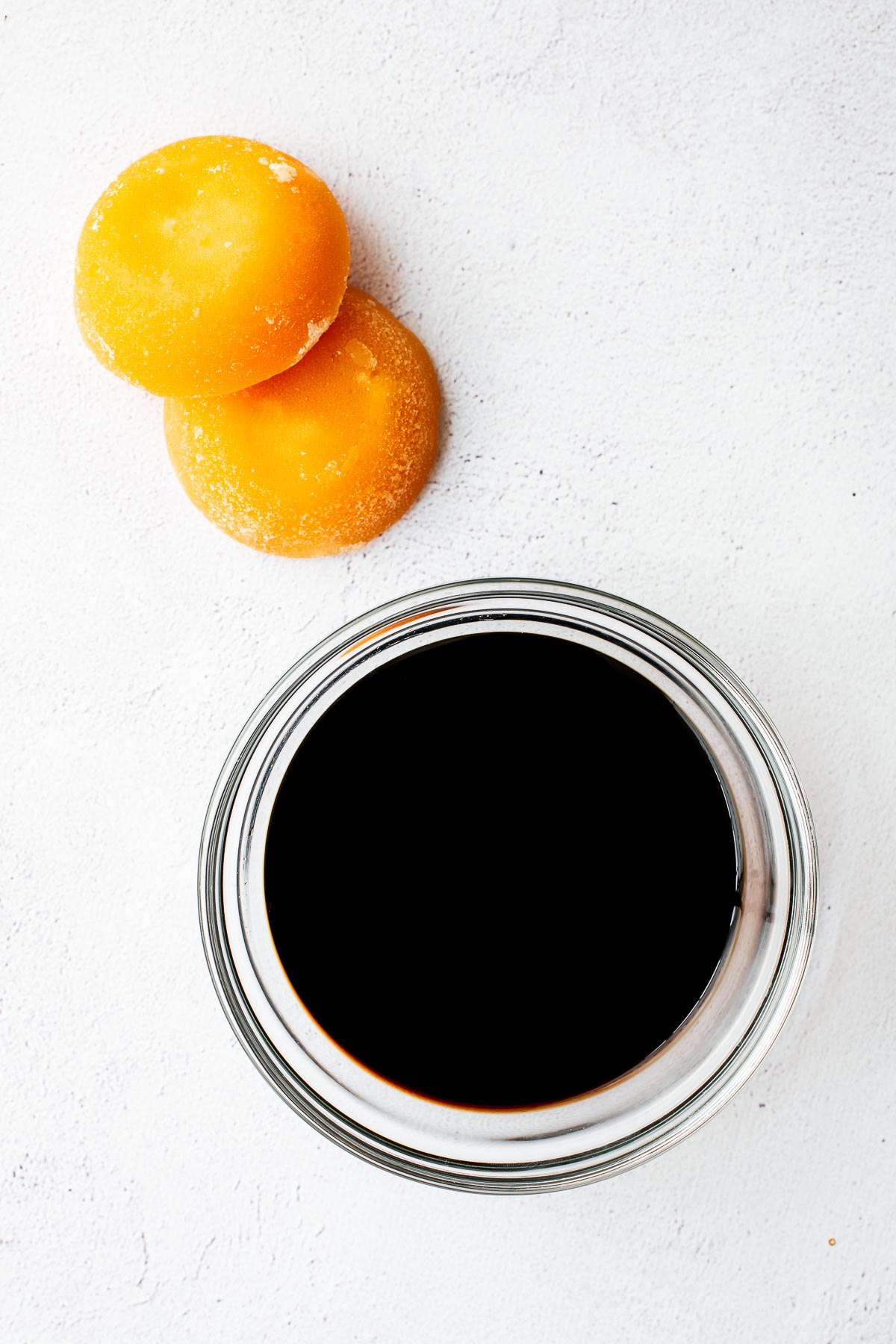
2. Soy sauce with palm sugar
Mix one part soy sauce (light or regular) with one part palm (or coconut) sugar by volume. For example, take one tablespoon soy sauce and add one tablespoon sugar. Stir until the sugar dissolves.
It is a great sweet soy sauce alternative if you don’t have the time to boil and cool homemade sweet soy sauce. Or if you only want a small amount.
The unboiled mixture won’t have the same syrupy consistency as sweet soy sauce, but the taste will deliver the required umami, saltiness, and sweetness. The same stands true for the following four substitute suggestions.
3. Regular soy sauce with brown sugar
Mix one part regular soy sauce – an all-purpose soy sauce like Kikkoman soy sauce – with one part brown sugar by volume. For example, take one tablespoon soy sauce and add one tablespoon brown sugar. Stir until the sugar dissolves.
Briefly heat the mixture in the microwave if the sugar struggles to dissolve.
Regular soy sauce works best with brown sugar when unboiled. Brown sugar lacks the caramel taste of palm or coconut sugar, but it will deliver a sweet and salty umami sauce in a pinch.
4. Soy sauce with maple syrup
Mix one part soy sauce with one part maple syrup by volume. For example, take one tablespoon soy sauce and add one tablespoon maple syrup. Stir until well combined.
Soy sauce and maple syrup make an excellent substitute for kecap manis. Good quality maple syrup has a deep caramel, almost smoky, flavour – similar to palm sugar.
5. Soy sauce with honey
Mix one part of regular soy sauce with half part mild honey by volume. For example, take one tablespoon of soy sauce and add half a tablespoon of honey. Keep stirring until it is well combined.
Briefly heat the mixture in the microwave if the honey struggles to dissolve.
Use neutral-tasting honey not to overpower the soy sauce.
6. Sweetened tamari
Tamari is a Japanese soy sauce (shoyu sauce). Tamari is most often made without wheat, whereas regular soy sauce can contain up to 50 percent wheat.
Always double-check the tamari label to confirm that it is wheat-free (if you need it to be).
Tamari can be richer in flavour, thicker in consistency and darker in colour than regular Chinese soy sauce. But you can substitute tamari for soy sauce and vice versa.
Make homemade kecap manis with tamari instead of soy sauce – see the sweet soy sauce recipe. Or mix tamari with a sweetener such as palm sugar, coconut sugar, brown sugar, maple syrup or honey – as outlined in substitutes 2 to 5.
7. Coconut aminos
Coconut aminos is the fermented sap from coconut blossoms blended with salt. It contains significantly less sodium than soy sauce and has a slightly sweet flavour with a much lighter hue.
While coconut aminos sauce is not as sweet and syrupy as kecap manis, it can be a great substitute for those on a restrictive diet or just in search of a healthier option. It is wheat-free, soy-free and sugar-free. It is a suitable soy sauce alternative for the Whole30 or paleo diets.
If you are not avoiding sweeteners, you can mix half a part sugar with one part coconut aminos – as outlined in substitutes 2 to 5.
8. Dark soy sauce (Lao chou)
Lao chou translates to “old” soy sauce in Chinese. It is thicker and darker in colour than regular soy sauce, thanks to added caramel, molasses or sugar and a longer fermentation period (hence the “old” soy sauce).
Dark soy sauce may have added sugar, but it is not nearly as sweet as kecap manis (which can contain around 50 percent sugar). It also has an intensely savoury umami taste that reminds me of yeast extract spreads like vegemite and marmite.
Don’t use dark soy sauce as a direct substitute for sweet soy sauce. First, add a quarter part sugar (palm, coconut or brown sugar) or maple syrup to match the sweetness of kecap manis.
9. Oyster sauce
Traditional oyster sauce is a dark, thick sauce of caramelised oyster juice. Nowadays, manufacturers take shortcuts and use oyster extract with cornstarch and more ingredients for a similar flavour at a lower cost.
Oyster sauce is not suitable for vegetarians, but vegetarian versions of oyster sauce (made from mushrooms) exist.
Keep in mind that oyster sauce is not the same as fish sauce. Oyster sauce is a sweet and viscous condiment with a slightly salty taste. Fish sauce is a clear, salty liquid with a strong, almost pungent, fish flavour. While fish sauce with sugar is delicious, it is not an ideal substitute for sweet soy sauce because of the overwhelming fish flavour.
While modern oyster sauce may have sugar, it is not sweet but rather intensely savoury and salty, like the ocean. Add a quarter part maple syrup and a splash of dark soy sauce if you want to use it as a substitute for sweet soy sauce.
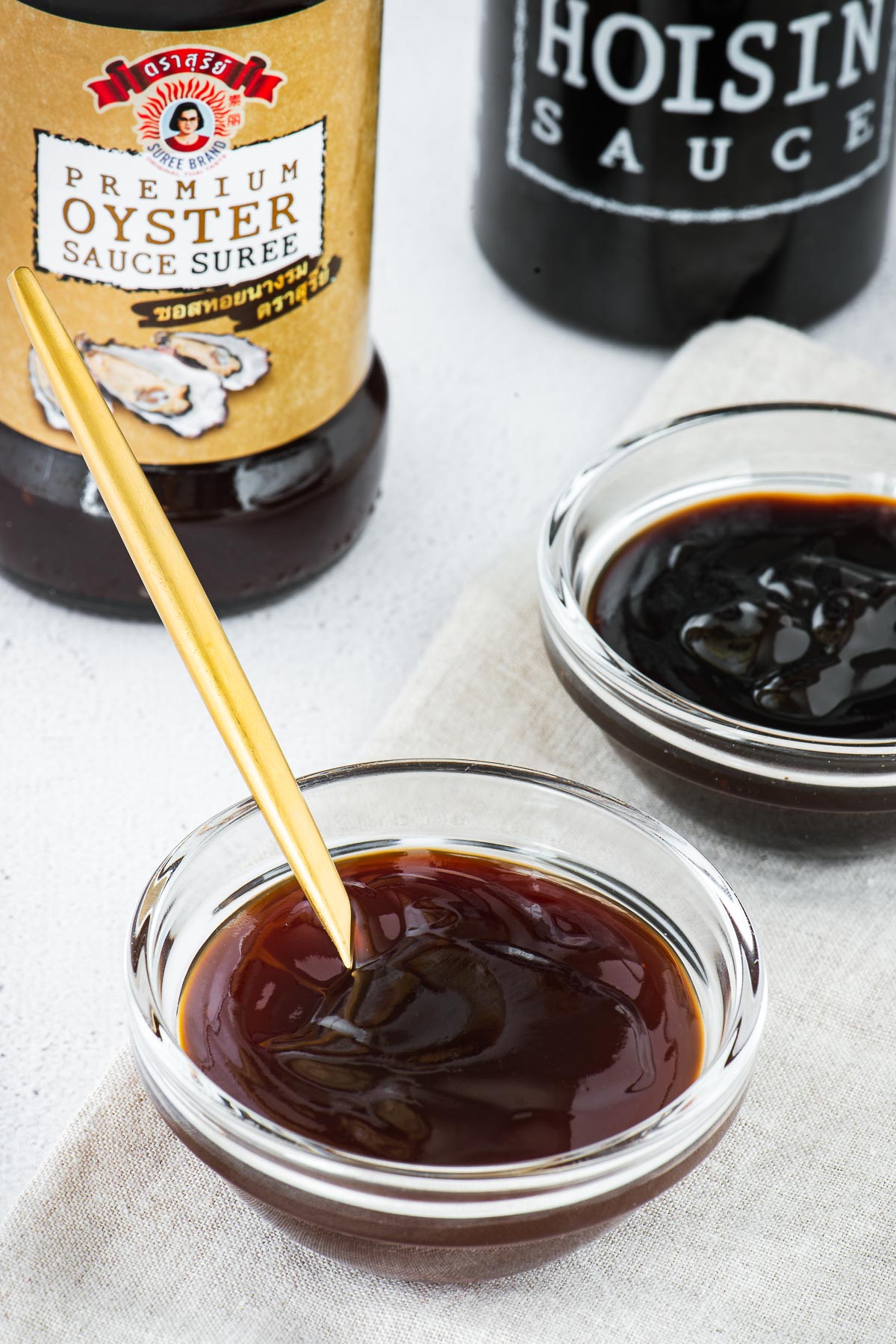
Read more about: Hoisin sauce vs oyster sauce
10. Hoisin sauce
The key ingredient of hoisin sauce is fermented soybean paste. It is a popular marinade or dipping sauce in Cantonese cooking.
Hoisin can also include starches such as sweet potato, wheat and rice. And other ingredients like sugar, soybeans, sesame seeds, vinegar, salt, garlic, chilli peppers and spices. Commercially sold hoisin sauce can also include preservatives and colouring agents.
It is thick, sweet and packed with umami flavours. If your hoisin sauce is so thick that it’s almost a paste, thin it with water or soy sauce before using it as a sweet soy sauce substitute.
11. Tianmian sauce
Tianmian sauce (sweet bean sauce, sweet flour sauce or sweet wheat paste) is a thick, smooth, dark brown or black paste used in Chinese cooking. The main ingredients here are fermented wheat flour and salt. It contains approximately 19 portions of wheat flour to one portion of soybean.
The taste can vary from mild and sweet to more intensely savoury, not too unlike kecap manis. But it is most similar to hoisin sauce in texture.
And like hoisin sauce, you can add a splash of soy sauce (or water) if your tianmian sauce is too thick.
How to use sweet soy sauce
Sweet soy sauce is delicious as a stir-fry sauce or as the base for dressings. Use the dressing for Asian salads, grilled veggies, pan-fried tofu, rice or noodle dishes.
- Nasi goreng is the Indonesian fried rice that celebrates kecap manis. My favourite Nasi Goreng recipe is from Serious eats (omit the shrimp paste to keep things vegetarian). Add some veggies before you add the rice to turn it into a main dish. Try diced broccoli and sliced cabbage.
- Make a quick sweet soy and ginger dressing by mixing two tablespoons of sweet soy sauce with one tablespoon of sesame oil, one tablespoon of toasted sesame seeds, one tablespoon of rice vinegar, and a teaspoon of grated ginger. Or try a sweet and spicy soy dressing to serve with spicy silken tofu.
- Create a quick bibimbap sauce by mixing two tablespoons of gochujang paste with two tablespoons of sweet soy sauce, a tablespoon of sesame oil and half a tablespoon of rice vinegar.
- Mix sweet soy sauce with sesame oil, Chinese five-spice, minced garlic and chilli flakes for a quick marinade. Use it for delicious oven-roasted oyster mushrooms.
Summary
There are many easy substitutes for kecap manis. Many shop-bought sweet and savoury fermented sauces (like hoisin sauce or tianmian sauce) can work in a pinch. And most homemade substitutes consist of soy sauce and a sweetener.
But the best sweet soy sauce substitute is homemade sweet soy sauce.
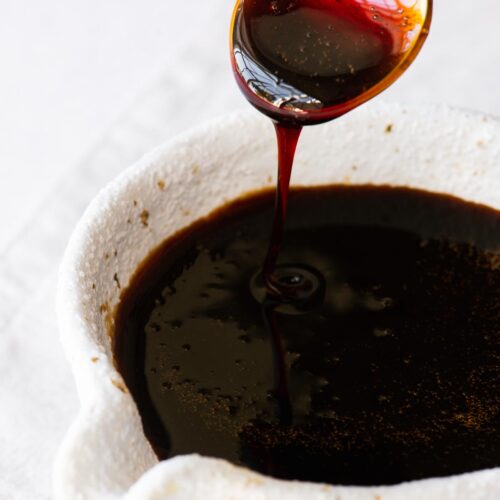
Equipment
- 1 small saucepan
Ingredients
- ½ cup soy sauce
- ¾ cup palm sugar (or coconut sugar)
- 1 star anise pod, whole (optional)
Instructions
- Add the sauce, sugar and star anise (optional) to a small saucepan.
- Bring the sauce to a boil over medium-high heat, then turn down to low heat and simmer for five to ten minutes, stirring often.
- The sweet soy sauce will thicken. Keep cooking until it has the consistency of maple syrup, ten minutes at most. It will continue to thicken as it cools down.
- Set it aside to cool down completely.
- Use it straight away, or store it in a sealed container in the fridge. It should last well over a month.
Notes
- Keep an eye on your sauce as it boils. If it is at risk of boiling over, remove it from the heat and keep stirring. Continue cooking once everything is under control.
- If you buy your palm sugar in a brick, you will need to grate it first.
- See the ingredients section for more ingredient details and substitutes.
Read more about my favourite Asian ingredients:
